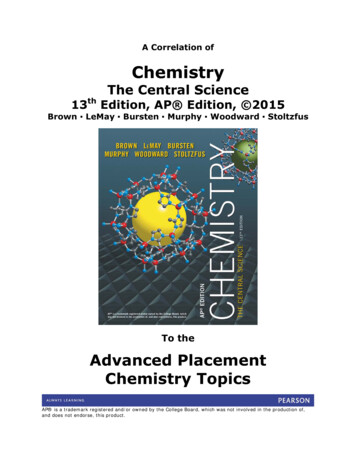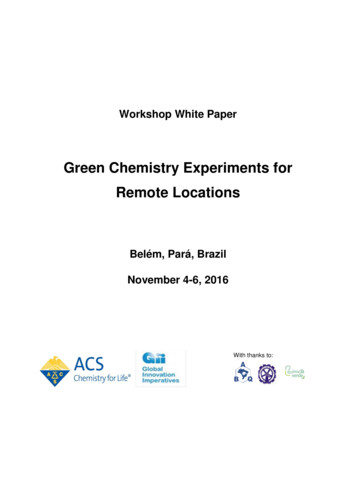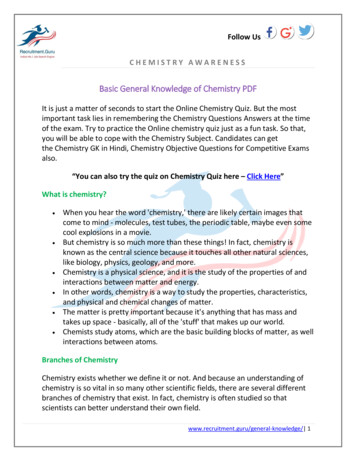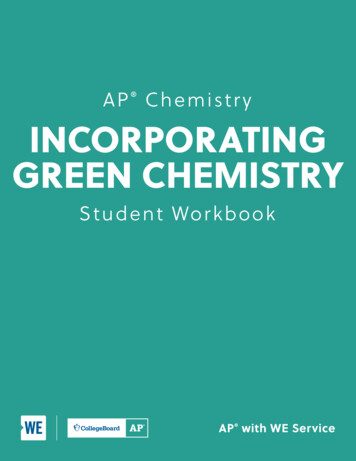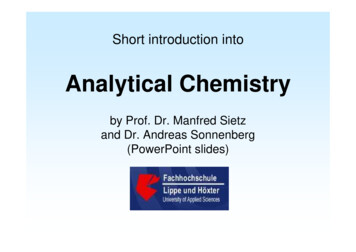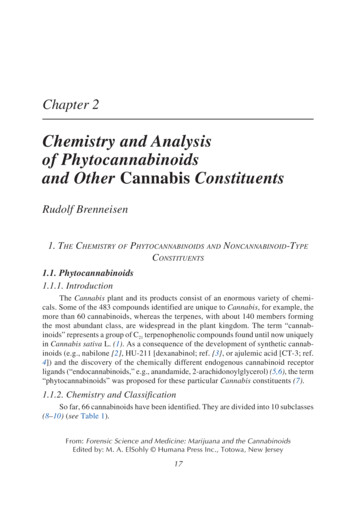
Transcription
Chemistry of Cannabis Constituents17Chapter 2Chemistry and Analysisof Phytocannabinoidsand Other Cannabis ConstituentsRudolf Brenneisen1. THE CHEMISTRY OF PHYTOCANNABINOIDS AND NONCANNABINOID-TYPECONSTITUENTS1.1. Phytocannabinoids1.1.1. IntroductionThe Cannabis plant and its products consist of an enormous variety of chemicals. Some of the 483 compounds identified are unique to Cannabis, for example, themore than 60 cannabinoids, whereas the terpenes, with about 140 members formingthe most abundant class, are widespread in the plant kingdom. The term “cannabinoids” represents a group of C21 terpenophenolic compounds found until now uniquelyin Cannabis sativa L. (1). As a consequence of the development of synthetic cannabinoids (e.g., nabilone [2], HU-211 [dexanabinol; ref. {3}, or ajulemic acid [CT-3; ref.4]) and the discovery of the chemically different endogenous cannabinoid receptorligands (“endocannabinoids,” e.g., anandamide, 2-arachidonoylglycerol) (5,6), the term“phytocannabinoids” was proposed for these particular Cannabis constituents (7).1.1.2. Chemistry and ClassificationSo far, 66 cannabinoids have been identified. They are divided into 10 subclasses(8–10) (see Table 1).From: Forensic Science and Medicine: Marijuana and the CannabinoidsEdited by: M. A. ElSohly Humana Press Inc., Totowa, New Jersey17
18BrenneisenTable 1Cannabinoids(continued)1. Cannabigerol (CBG) type: CBG was the first cannabinoid identified (11), and its precursor cannabigerolic acid (CBGA) was shown to be the first biogenic cannabinoidformed in the plant (12). Propyl side-chain analogs and a monomethyl ether derivative are other cannabinoids of this group.2. Cannabichromene (CBC) type: Five CBC-type cannabinoids, mainly present as C5analogs, have been identified.3. Cannabidiol (CBD) type: CBD was isolated in 1940 (13), but its correct structure wasfirst elucidated in 1963 by Mechoulam and Shvo (14). Seven CBD-type cannabinoidswith C1 to C5 side chains have been described. CBD and its corresponding acid CBDA
Chemistry of Cannabis Constituents19Table 1 (continued)(continued)are the most abundant cannabinoids in fiber-type Cannabis (industrial hemp). Isolated in 1955, CBDA was the first discovered cannabinoid acid.4. '9-Tetrahydrocannabinol (THC) type: Nine THC-type cannabinoids with C1 to C5side chains are known. The major biogenic precursor is the THC acid A, whereas
20BrenneisenTable 1 (continued)(continued)THC acid B is present to a much lesser extent. THC is the main psychotropic principle; the acids are not psychoactive. THC -3-pentyl-6H-dibenzo[b,d]pyran-1-ol) was first isolated in 1942 (15), but thecorrect structure assignment by Gaoni and Mechoulam took place in 1964 (16).
Chemistry of Cannabis Constituents21Table 1 (continued)(continued)5. '8-THC type: '8-THC and its acid precursor are considered as THC and THC acidartifacts, respectively. The 8,9 double-bond position is thermodynamically more stablethan the 9,10 position. '8-THC is approx 20% less active than THC.
22BrenneisenTable 1 (continued)(continued)6. Cannabicyclol (CBL) type: Three cannabinoids characterized by a five-atom ring andC1-bridge instead of the typical ring A are known: CBL, its acid precursor, and the C3side-chain analog. CBL is known to be a heat-generated artifact from CBC.7. Cannabielsoin (CBE) type: Among the five CBE-type cannabinoids, which are artifacts formed from CBD, are CBE and its acid precursors A and B.
Chemistry of Cannabis Constituents23Table 1 (continued)(continued)8. Cannabinol (CBN) and Cannabinodiol (CBND) types: Six CBN- and two CBND-typecannabinoids are known. With ring A aromatized, they are oxidation artifacts of THCand CBD, respectively. Their concentration in Cannabis products depends on age andstorage conditions. CBN was first named in 1896 by Wood et al. (17) and its structureelucidated in 1940 (18).
24BrenneisenTable 1 (continued)(continued)9. Cannabitriol (CBT) type: Nine CBT-type cannabinoids have been identified, whichare characterized by additional OH substitution. CBT itself exists in the form of bothisomers and the racemate, whereas two isomers (9-a- and 9-b-hydroxy) of CBTVwere identified. CBDA tetrahydrocannabitriol ester (ester at 9-hydroxy group) is theonly reported ester of any naturally occurring cannabinoids.10. Miscellaneous types: Eleven cannabinoids of various unusual structure, e.g., with a furanoring (dehydrocannabifuran, cannabifuran), carbonyl function (cannabichromanon, 10oxo-G-6a-tetrahydrocannabinol), or tetrahydroxy substitution (cannabiripsol), are known.
Chemistry of Cannabis Constituents25Table 1 (continued)(continued)1.1.3. THC Potency TrendsFrom 1980 to 1997, a total of 35,213 samples of confiscated Cannabis products(Cannabis, hashish, hashish oil) representing more than 7717 tons seized in the UnitedStates were analyzed by gas chromatography (GC) (19). The mean THC concentration increased from less than 1.5% in 1980 to 4.2% in 1997. The maximum levelsfound were 29.9 and 33.1% in marijuana and sinsemilla Cannabis, respectively. Hashish
26BrenneisenTable 1 (continued)(continued)and hashish oil showed no particular potency trend. The highest THC concentrationsmeasured were 52.9 and 47.0%, respectively. Two studies performed in Switzerlandfrom 1981 to 1985 (20) and 2002 to 2003 (21) found mean THC concentrations inmarijuana samples of 1.4 and 12.9%, respectively. Maximum levels were 4.8 and 28.4%,respectively. Reasons for this enormous increase in potency include progress in breed-
Chemistry of Cannabis Constituents27Table 1 (continued)ing, the tendency to cultivate under indoor conditions, and the worldwide access toand exchange of seeds originating from high-THC cultivars via the Internet (22).1.1.4. THC in Hemp Seed ProductsThe presence of THC in hemp seed products is predominantly the result of external contact of the seed hull with cannabinoid-containing resins in bracts and leavesduring maturation, harvesting, and processing (23–25). The seed kernel is not entirelyfree of THC but contains, depending on the hemp variety, less than 0.5 Pg/g. Studieson hemp oil conducted in the United States, Germany, and Switzerland have shownTHC levels from 11 to 117, 4 to 214, and up to 3568 Pg/g, respectively (24,26–28).These high levels were attributed to seeds from THC-rich, “drug-type” varieties, andthe lack of adequate cleaning procedures. In recent years, more careful seed dryingand cleaning have considerably lowered the THC content of seeds and oil available inthe United States (23,24). However, oils and hulled seeds containing 10–20 and 2–3 Pg/gTHC, respectively, are still found on the US market.
28Brenneisen1.2. Noncannabinoid-Type Constituents1.2.1. TerpenoidsThe typical scent of Cannabis results from about 140 different terpenoids. Isoprene units (C 5H 8) form monoterpenoids (C 10 skeleton), sesquiterpenoids (C 15),diterpenoids (C20), and triterpenoids (C30; see Table 2). Terpenoids may be acyclic,monocyclic, or polycyclic hydrocarbons with substitution patterns including alcohols,ethers, aldehydes, ketones, and esters. The essential oil (volatile oil) can easily beobtained by steam distillation or vaporization. The yield depends on the Cannabistype (drug, fiber) and pollination; sex, age, and part of the plant; cultivation (indoor,outdoor etc.); harvest time and conditions; drying; and storage (29–31). For example,fresh buds from an Afghani variety yielded 0.29% essential oil (32). Drying and storage reduced the content from 0.29 after 1 week and 3 months to 0.20 and 0.13%,respectively (32). Monoterpenes showed a significantly greater loss than sesquiterpenes, but none of the major components completely disappeared in the drying process.About 1.3 L of essential oil per ton resulted from freshly harvested outdoor-grownCannabis, corresponding to about 10 L/ha (29). The yield of nonpollinated(“sinsemilla”) Cannabis at 18 L/ha was more than twofold compared with pollinatedCannabis (8 L/ha) (30). Sixty-eight components were detected by GC and GC/massspectrometry (MS) in fresh bud oil distilled from high-potency, indoor-grown Cannabis (32). The 57 identified constituents were 92% monoterpenes, 7% sesquiterpenes, and approx 1% other compounds (ketones, esters; refs. 9 and 32). The dominatingmonoterpenes were myrcene (67%) and limonene (16%). In the essential oil fromoutdoor-grown Cannabis, the monoterpene concentration varied between 47.9 and92.1% of the total terpenoid content (29). The sesquiterpenes ranged from 5.2 to 48.6%.The most abundant monoterpene was E-myrcene, followed by trans-caryophyllene,D-pinene, trans-ocimene, and D-terpinolene. “Drug-type” Cannabis generally contained less caryophyllene oxide than “fiber-type” Cannabis. Even in “drug-type” Cannabis, the THC content of the essential oil was not more than 0.08% (29). In theessential oil of five different European Cannabis cultivars, the dominating terpeneswere myrcene (21.1–35.0%), D-pinene (7.2–14.6%), D-terpinolene (7.0–16.6%), transcaryophyllene (12.2.–18.9%), and D-humulene (6.1–8.7%; ref. 33). The main differences between the cultivars were found in the contents of D-terpinolene and D-pinene.Other terpenoids present only in traces are sabinene, D-terpinene, 1,8-cineole(eucalyptol), pulegone, J-terpinene, terpineol-4-ol, bornyl acetate, D-copaene,alloaromadendrene, viridiflorene, E-bisabolene, J-cadinene, trans-E-farnesene, transnerolidol, and E-bisabolol (29,32,34).1.2.2. HydrocarbonsThe 50 known hydrocarbons detected in Cannabis consist of n-alkanes ranging from C 9 to C 39, 2-methyl-, 3-methyl-, and some dimethyl alkanes (10,35). Themajor alkane present in an essential oil obtained by extraction and steam distillation was the n-C 29 alkane nonacosane (55.8 and 10.7%, respectively). Other abundant alkanes were heptacosane, 2,6-dimethyltetradecane, pentacosane, hexacosane,and hentriacontane.
Chemistry of Cannabis Constituents29Table 2Terpenoids of the Essential Oil From Cannabis(continued)1.2.3. Nitrogen-Containing CompoundsCannabis sativa L. is one of the rare psychotropic plants in which the centralnervous system activity is not linked to particular alkaloids. However, two spermidine-type alkaloids (see Table 3) have been identified among the more than 70 nitrogen-containing constituents. Other nitrogenous compounds found are the quartenarybases choline, trigonelline, muscarine, isoleucine betaine, and neurine. Among the 8amides are, for example, N-trans-feruloyltyramine, N-p-coumaroyltyramine, and Ntrans-caffeoyltyramine (see Table 4). Five lignanamide derivatives have been isolated, including cannabisin A, B, C, and D (see Table 5).Twelve simple amines, including piperidine, hordenine, methylamine, ethylamine,and pyrrolidine, are known. The three proteins detected are edestin, zeatin, and
30BrenneisenTable 2 (continued)(continued)zeatinnucleoside; the six enzymes are edestinase, glucosidase, polyphenoloxydase,peptidase, peroxidase, and adenosine-5-phosphatase. The 18 amino acids are of a structure common for plants.1.2.4. CarbohydratesCommon sugars are the predominant constituents of this class. Thirteenmonosacharides (fructose, galactose, arabinose, glucose, mannose, rhamnose, etc.),two disaccharides (sucrose, maltose), and five polysaccharides (raffinose, cellulose,hemicellulose, pectin, xylan) have been identified so far. In addition, 12 sugar alcohols
Chemistry of Cannabis Constituents31Table 2 (continued)(continued)and cyclitols (mannitol, sorbitol, glycerol, inositol, quebrachitol, etc.) and two aminosugars (galactosamine, glucosamine) were found.1.2.5. FlavonoidsTwenty-three commonly occurring flavonoids have been identified in Cannabis,existing mainly as C-/O- and O-glycosides of the flavon- and flavonol-type aglycones
32BrenneisenTable 2 (continued)(continued)apigenin, luteolin, quercetin, and kaempferol (see Table 6; ref. 36). Orientin, vitexin,luteolin-7-O-glucoside, and apigenin-7-O-glucoside were the major flavonoid glycosides present in low-THC Cannabis cultivars (37). The cannflavins A and B are uniqueto Cannabis (38,39).1.2.6. Fatty AcidsA total of 33 different fatty acids, mainly unsaturated fatty acids, have been identified in the oil of Cannabis seeds. Linoleic acid (53–60% of total fatty acids), D-
Chemistry of Cannabis Constituents33Table 2 (continued)(continued)linolenic acid (15–25%), and oleic acid (8.5–16%) are most common (see Table 7)(40). Other unsaturated fatty acids are γ-linolenic acid (1–4%), stearidonic acid (0.4–2%), eicosanoic acid ( 0.5%), cis-vaccenic acid, and isolinolenic acid. The saturatedfatty acids are palmitic acid (6–9%), stearic acid (2–3.5%), arachidic acid (1–3%),behenic acid ( 0.3%), myristic acid, lignoceric acid, caproic acid, heptanoic acid, ca-
34BrenneisenTable 2 (continued)(continued)prylic acid, pelargonic acid, capric acid, lauric acid, margaric acid, and isoarachidicacid. The fatty acid spectrum of Cannabis seeds does not significantly vary in oilproduced from drug (THC) or low-THC (hemp, fiber) type Cannabis (41). For theTHC content of Cannabis seeds and seed oil, see Section 1.1.4.
Chemistry of Cannabis Constituents35Table 2 (continued)1.2.7. Noncannabinoid PhenolsThirty-four noncannabinoid phenols are known: nine with spiro-indan-type structure (e.g., cannabispiran, isocannabispiran), nine dihydrostilbenes (e.g., cannabistilbene-
36BrenneisenTable 3Spermidine AlkaloidsTable 4AmidesI, -II), three dihydrophenanthrenes (e.g., cannithrene-1, -2), and six phenols, phenolmethylethers, and phenolic glycosides (phloroglucinol glucoside; see Table 8).1.2.8. Simple Alcohols, Aldehydes, Ketones, Acids, Esters,and LactonesSeven alcohols (e.g., methanol, ethanol, 1-octene-3-ol), 12 aldehydes (e.g.,acetaldehyde, isobutyraldehyde, pentanal), 13 ketones (e.g., acetone, heptanone-2, 2methyl-2-heptene-6-one), and 21 acids (e.g., arabinic acid, azealic acid, gluconic acid)have been identified.
Chemistry of Cannabis Constituents37Table 5Lignanamide Derivatives1.2.9. OtherAmong the 11 phytosterols known are campesterol, ergosterol, E-sitosterol, andstigmasterol. Vitamin K is the only vitamin found in Cannabis, whereas carotene andxanthophylls are reported pigments. Eighteen elements were detected (e.g., Na, K, Ca,Mg, Fe, Cu, Mn, Zn, Hg).
38BrenneisenTable 6C- and O-Glycosides Forming Flavonoid Aglycones and C-Glycosides(continued)1.3. Pharmacological Characteristics of Cannabinoids and OtherCannabis ConstituentsTHC is the pharmacologically and toxicologically most relevant and best studied constituent of the Cannabis plant, responsible for most of the effects of naturalCannabis preparations (42). (A MEDLINE search covering the period 1993–2003 andusing the keywords “tetrahydrocannabinol” and “pharmacology” produced about 1000citations.) THC mainly acts through binding to the CB-1 receptor (see Chapter 6). Thenatural (-)-trans isomer of THC is 6- to 100-fold more potent than the ( )-trans isomer. A review of the pharmacology, toxicology, and therapeutic potential of Cannabis, cannabinoids, and other Cannabis constituents is given in refs. 43–53. It isclaimed that Cannabis as a polypharmaceutical herb may provide two advantages over
Chemistry of Cannabis Constituents39Table 6 (continued)single-ingredient synthetic drugs: (1) the therapeutic effects of the primary activeCannabis constituents may be synergized by other compounds, and (2) the side effectsof the primary constituents may be mitigated by other compounds (34). Thus, Cannabishas been characterized as a “synergistic shotgun,” in contrast, for example, to dronabinol(synthetic THC, Marinol ), a single-ingredient “silver bullet” (54). A recent studycompared the subjective effects of orally administered and smoked THC alone andTHC within Cannabis preparations (brownies, cigarettes; refs. 55 and 56). THC andCannabis in both application forms produced similar, dose-dependent subjectiveeffects, and there were few reliable differences between the THC-only and wholeplant conditions.CBD is the next-best phytocannabinoid after THC. An overview of the pharmacology and clinical relevance of CBD can be found in refs. 34, 57, and 58. Of clinicalrelevance could be its reported ability to reduce anxiety and the other unpleasant psychological side effects of THC. Among the underlying mechanisms is the potent inhibition of the cytochrome P450 3A11, which biotransforms THC to the fourfold morepsychoactive 11-hydroxy-THC (59).
40BrenneisenTable 7Unsaturated Fatty Acids From Cannabis Seed OilIt has been suggested that the terpenoid constituents of Cannabis modulate THCactivity, for example, by binding to cannabinoid receptors, modulating the THC receptoraffinity, or altering its pharmacokinetics (e.g., by changing the blood–brain barrier;ref. 60). Whereas the anti-inflammatory and antibiotic activity of Cannabis terpenoids is known and has been used therapeutically for a long time, the serotonergiceffect at 5-HT1A and 5-HT2A receptors of the essential oil, which could explain Cannabis-mediated analgesia and mood alteration, has only recently been demonstrated(61). E-Myrcene, the most abundant monoterpene in Cannabis, has analgesic, antiinflammatory, antibiotic, and antimutagenic properties (34). E-Caryophyllene, the mostcommon sesquiterpene, exhibits anti-inflammatory, cytoprotective (gastric mucosa),and antimalarial activity. The pharmacological effects of other Cannabis terpenes arediscussed by McPartland and Russo (34).Apigenin, a flavonoid found in nearly all vascular plants, excerts a wide range ofbiological effects, including many properties shared by terpenoids and cannabinoids.It selectively binds with high affinity to benzodiazepine receptors, thus explaining itsanxiolytic activity (62). The pharmacology of other Cannabis flavonoids is reviewedin ref. 34.2. ANALYSIS OF PHYTOCANNABINOIDSInstrumental methods are most often used for the identification, classification(e.g., fiber type, drug type), and individualization (e.g., source tracing) of Cannabisplants and products. Because of the complex chemistry of Cannabis, separation techniques, such as GC or liquid chromatography, often coupled with MS, are necessaryfor the acquisition of the typical chemical profiles and the sensitive, specific, qualitative, and/or quantitative (e.g., THC potency) determination of Cannabis constituents.However, especially for screening purposes and on-site field testing, noninstrumentaltechniques like thin-layer chromatography (TLC) and color reactions are helpful, too.
Chemistry of Cannabis Constituents41Table 8Noncannabinoid Phenols2.1. MicroscopyIdentifying a plant sample as Cannabis sativa L. is the first step. The botanicalidentification of plant specimens consists of physical examination of the intact plant
42Brenneisenmorphology and habit (leaf shape, male and female inflorescenses, etc.) followed bythe microscopical examination of leaves for the presence of cystolith hairs (22,63–69). The very abundant trichomes, which are present on the surface of the fruiting andflowering tops of Cannabis, are the most characteristic features to be found in themicroscopic examination of Cannabis products (not liquid Cannabis, hashish oil).Sometimes microscopic evidence is still available in smoked Cannabis residues.2.2. Color ReactionsIt must be stressed that positive reactions to color tests are only presumptiveindications of the possible presence of Cannabis products or materials containingCannabis products. A few other materials, often harmless and uncontrolled by national legislation or international treaties, may react with similar colors to the testreagents. It is mandatory for the laboratory to confirm such results by the use of analternative technique, which should be based on MS (70). The most common colorspot tests include those developed by Duquenois and its modifications (70–74). Astudy of 270 different plant species and 200 organic compounds has shown that theDuquenois–Levine modification is most specific (71). The fast blue B salt test is themost common color reaction for the visualization of TLC patterns but may also beused as spot test on a filter paper (70).2.3. Chromatographic Techniques2.3.1. Thin-Layer ChromatographyOne- and two-dimensional TLC is suited for the acquisition of qualitative cannabinoid profiles from plant material (70,73,75,76). Fast blue salt B or BB are usedfor visualization and result in characteristically colored spot patterns (68). Forquantitation, instrumental TLC coupled to densitometry is necessary. High-pressureTLC and overpressured layer chromatography have been developed for the reproducible and fast determination and isolation of neutral and acidic cannabinoids (77–79).2.3.2. Gas Chromatography, Gas Chromatography/Mass SpectrometryGC with flame ionization or MS detection is now the best established method forthe analysis of Cannabis and its products (25,32,70,77,80–92). Derivatization is necessary (e.g., silylation or methylation) when information about cannabinoid acids, thedominating cannabinoids in the plant (see Section 1.1.), is required. The total cannabinoid content, i.e., the amount of neutral cannabinoids plus the neutral cannabinoidsformed by decarboxylation of the acidic cannabinoids, is determined when the GCanalysis is performed without derivatization (89). GC/MS is the method of choice forcreating Cannabis profiles and signatures (chemical fingerprints), a tool for attributing the country of origin, the conditions of cultivation (indoor, outdoor), an so on (seeChapter 3; refs. 21 and 87).2.3.3. High-Performance Liquid ChromatographyHigh-performance liquid chromatography makes possible the simultaneousdetermination of neutral and acidic phytocannabinoids without derivatization. Reversedphase columns and preferably solvent programmed gradient systems are required forthe separation of major and minor cannabinoids and their corresponding acids, e.g.,
Chemistry of Cannabis Constituents43for chemotyping (CBD-, THC, CBD/THC-type etc.), estimating the age (ratio acidic/neutral cannabinoids) of Cannabis, studying the effect of manufacturing processesand storage conditions, batch comparison, or direct quantification of THC in aqueousherbal preparations (e.g., Cannabis tea) (81,82,93–98). Detection is usually performedby UV (70,80,87,98–101) and diode array photometers (93), as well as by fluorescence, electrochemically (102), and, recently, MS (103).2.3.4. Other TechniquesThe applicability of capillary electrochromatography with photodiode array UVdetection for the analysis of phytocannabinoids has been demonstrated (104).Supercritical fluid chromatography coupled to atmospheric pressure chemical ionization/MS is characterized by shorter analysis times than GC or high-performance liquid chromatography and does not require derivatization (105).2.4. DNA TestingAfter a Cannabis sample has been identified and classified, it may becomeimportant to individualize the specimen for forensic and intelligence purposes (22).Tracing the source of origin can be performed on a chemical, e.g., by using chromatographic–spectroscopic profiles (see also Chapter 3) or a genetic base. For DNA profiling (22,106–110), the following techniques are used: randomly amplified polymorphicDNA (111), amplified fragment length polymorphism (112), short tandem repeats(113,114), inter-simple sequence repeats (115), internal transcribed spacer II (116),and microsatellite markers (117). An overview and description of the different DNAtesting methods is given in ref. 22.REFERENCES1. Mechoulam, R. and Gaoni, Y. (1967) Recent advances in the chemistry of hashish.Fortschr. Chem. Org. Naturst. 25, 175–213.2. Ward, A. and Holmes, B. (1985) Nabilone. A preliminary review of its pharmacologicalproperties and therapeutic use. Drugs 30, 127–144.3. Mechoulam, R., Lander, N., Breuer, A., and Zahalka, J. (1990) Synthesis of the individual, pharmacologically distinct, enantiomers of a tetrahydrocannabinol derivative. Tetrahedron Asymmetry 1, 315–318.4. Burstein, S. H., Audette, C. A., Breuer, A., et al. (1992) Synthetic nonpsychotropic cannabinoids with potent antiinflammatory, analgesic, and leukocyte antiadhesion activities.J. Med. Chem. 35, 3135–3141.5. Di Marzo, V. and Fontana, A. (1995) Anandamide, an endogenous cannabinomimeticeicosanoid: ‘killing two birds with one stone’. Prostaglandins Leukot. Essent. Fatty Acids 53, 1–11.6. Devane, W. A., Hanus, L., Breuer, A., et al. (1992) Isolation and structure of a brainconstituent that binds to the cannabinoid receptor. Science 258, 1946–1949.7. Pate, D. (1999) Anandamide structure-activity relationships and mechanisms of actionon intraocular pressure in the normotensive rabbit model, PhD thesis, University ofKuopio, Kuopio, Finland.8. Turner, C. E., Elsohly, M. A., and Boeren, E. G. (1980) Constituents of Cannabis sativaL. XVII. A review of the natural constituents. J. Nat. Prod. 43, 169–234.9. Ross, S. A. and ElSohly, M. A. (1995) Constituents of Cannabis sativa L. XXVIII—Areview of the natural constituents: 1980–1994. Zagazig J. Pharm. Sci. 4, 1–10.
44Brenneisen10. ElSohly, M. (2002) Chemical constituents of Cannabis, in Cannabis and cannabinoids—Pharmacology, Toxicology and Therapeutic Potential (Grotenhermen, F. and Russo, E.,eds.), Haworth Press, New York, pp. 27–36.11. Gaoni, Y. and Mechoulam, R. (1964) The structure and synthesis of cannabigerol, a newhashish constituent, in Proc. Chem. Soc., London, p. 82.12. Shoyama, Y., Yagi, M., Nishioka, I., and Yamauchi, T. (1975) Biosynthesis of cannabinoid acids. Phytochemistry 14, 2189–2192.13. Adams, R., Hunt, M., and Clark, J. (1940) Structure of cannabidiol, a product isolatedfrom the marihuana extract of Minnesota wild hemp. I. J. Am. Chem. Soc. 62, 196–199.14. Mechoulam, R. and Shvo, Y. (1963) Hashish—I. The structure of cannabidiol. Tetrahedron 19, 2073–2078.15. Wollner, H., Matchett, J., Levine, J., and Loewe, S. (1942) Isolation of a physiologicallyactive tetrahydrocannabinol from Cannabis sativa resin. J. Am. Chem. Soc. 64, 26–29.16. Gaoni, Y. and Mechoulam, R. (1964) Isolation, structure and partial synthesis of an active constituent of hashish. J. Am. Chem. Soc. 86, 1646–1647.17. Wood, T., Spivey, W., and Easterfield, T. (1896) XL. Charas. The resin of Indian hemp.J. Chem. Soc. 69, 539.18. Adams, R., Baker, B., and Wearn, R. (1940) Structure of cannabinol III. Synthesis ofcannabinol, 1-hydroxy-3-n-amyl-6,6,9-trimethyl-6-dibenzopyran. J. Am. Chem. Soc. 62,2204–2207.19. ElSohly, M., Ross, S., Mehmedic, Z., Arafat, R., Yi, B., and Banahan, B.F., 3rd (2000)Potency trends of delta-9-THC and other cannabinoids in confiscated marijuana from1980–1997. J. Forens. Sci. 45, 24–30.20. Brenneisen, R. (1986) The cannabinoid content in Cannabis products confiscated in Switzerland. Arch. Kriminol. 177, 95–104.21. Brenneisen, R. and Meyer, P. Swiss Cannabis Profiling Project, University of Bern andSwiss Federal Office of Public Health (unpublished data).22. Miller Coyle, H., Palmbach, T., Juliano, N., Ladd, C., and Lee, H. C. (2003) An overviewof DNA methods for the identification and individualization of marijuana. Croat. Med. J.44, 315–321.23. ElSohly, M. (2003) Practical challenges to positive drug tests for marijuana. Clin. Chem.49, 1037–1038.24. Leson, G., Pless, P., Grotenhermen, F., Kalant, H., and ElSohly, M. A. (2001) Evaluating theimpact of hemp food consumption on workplace drug tests. J. Anal. Toxicol. 25, 691–698.25. Ross, S. A., Mehmedic, Z., Murphy, T. P., and Elsohly, M. A. (2000) GC-MS analysis ofthe total delta9-THC content of both drug- and fiber-type cannabis seeds. J. Anal. Toxicol.24, 715–717.26. Bosy, T. Z. and Cole, K. A. (2000) Consumption and quantitation of delta-9-tetrahydrocannabinol in commercially available hemp seed oil products. J. Anal. Toxicol. 24, 562–6.27. Mediavilla, V., Derungs, R., Känzig, A., and Mägert, A. (1997) Qualität von Hanfsamenölaus der Schweiz. Agrarforschung 4, 449–451.28. Lehmann, T., Sager, F., and Brenneisen, R. (1997) Excretion of cannabinoids in urineafter ingestion of cannabis seed oil. J. Anal. Toxicol. 21, 373–375.29. Mediavilla, V. and Steinemann, S. (1997) Essential oil of Cannabis sativa L. strains. J.Int. Hemp Assoc. 4, 80–82.30. Meier, C. and Mediavilla, V. (1998) Factors influencing the yield and the quality of hemp(Cannabis sativa L.) essential oil. J. Int. Hemp Assoc. 5, 16–20.31. Lehmann, T. (1995) Chemical profiling of Cannabis sativa L., PhD thesis, University ofBern, Dep. of Pharmaceutical Sciences, Bern, Switzerland.32. Ross, S.A. and ElSohly, M. A. (1996) The volatile oil composition of fresh and air-driedbuds of Cannabis sativa. J. Nat. Prod. 59, 49–51.
Chemistry of Cannabis Constituents4533. Novak, J., Zitterl-Eglseer, K., Deans, S. G., and Franz, C. M. (2001) Essential oils ofdifferent cultivars of Cannabis sativa L. and their antimicrobial activity. Flavour Fragr.J. 16, 259–262.34. McPartland, J. M. and Russo, E. B. (2001) Cannabis and cannabis extracts: greater thanthe sum of their parts? J. Cann. Therap. 1, 103–132.35. Hendriks, H., Malingré, T. M., Batterman, S., and Bos, R. (1977) Alkanes of the essentialoil of Cannabis sativa. Phytochemistry 16, 719–721.36. McPartland, J. and Mediavilla, V. (2002) Noncannabinoid components, in Cannabis andCannabinoids—Pharmacology, Toxicology, and Therapeutic Potential (Grotenhermen,F., and Russo, E., eds.), Haworth Press, New York, pp. 401–409.37. Vanhoenacker, G., Van Rompaey, P., De Keukeleire, D., and Sandra, P. (2002) Chemotaxonomic features associated with flavonoids of cannabinoid-free cannabis (Cannabis sativa subsp. sativa L.) in relation to hops (Humulus lupulus L.). Nat. Prod. Lett. 16, 57–63.38. Barrett, M. L., Scutt, A. M., and Evans, F. J. (1986) Cannflavin A and B, prenylatedflavones from Cannabis sativa L. Experientia 42, 452–453.39. Barrett, M. L., Gordon, D., and Evans,
Cannabis, corresponding to about 10 L/ha (29). The yield of nonpollinated (“sinsemilla”)Cannabis at 18 L/ha was more than twofold compared with pollinated Cannabis (8 L/ha) (30). Sixty-eight components were detected by GC and GC/mass spectrometry (MS) in fresh bud oil distilled from high-potency,






